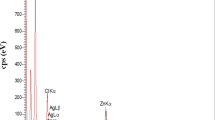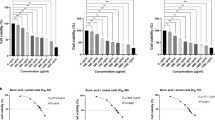Abstract
As a non-toxic metal to humans, zinc is essential for cell proliferation, differentiation, regulation of DNA synthesis, genomic stability and mitosis. Zinc homeostasis in cells, which is crucial for normal cellular functioning, is maintained by various protein families including ZnT (zinc transporter/SLC30A) and ZIP (Zrt-, Irt-like proteins/SLC39A) that decrease and increase cytosolic zinc availability, respectively. In this study, we investigated the influences of a specific concentration range of ZnSO4 on cell cycle and apoptosis by flow cytometry, and cell viability by MTT method in MDAMB231, HepG2 and 293 T cell lines. Fluorescent sensors NBD-TPEA and the counterstain for nuclei Hoechst 33342 were used to stain the treated cells for observing the localisation and amount of Zn2+ via laser scanning confocal microscope. It was found that the influence manners of ZnSO4 on cell cycle, apoptosis and cell viability in various cell lines were different and corresponding to the changes of Zn2+ content of the three cell lines, respectively. The significant increase on intracelluar zinc content of MDAMB231 cells resulted in cell death, G1 and G2/M cell cycle arrest and increased apoptotic fraction. Additionally, the mRNA expression levels of ZnT and ZIP families in the three cell lines, when treated with high concentration of ZnSO4, increased and decreased corresponding to their functions, respectively.





Similar content being viewed by others
References
Sharif R, Thomas P, Zalewski P et al (2012) The role of zinc in genomic stability. Mutat Res 733:111–121
Bao B, Prasad AS, Beck FWJ et al (2003) Zinc modulates mRNA levels of cytokines. Am J Physiol Endocrinol Meta 285:1095–1102
Plum LM, Rink L, Haase H (2010) The essential toxin: impact of zinc on human health. Int J Environ Res Public Health 7:1342–1365
Lichten LA, Cousins RJ (2009) Mammalian zinc transporters: nutritional and physiologic regulation. Annu Rev Nutr 29:153–176
Fukada T, Yamasaki S, Nishida K et al (2011) Zinc homeostasis and signaling in health and diseases. J Biol Inorg Chem 16:1123–1134
Liuzzi JP, Cousins RJ (2004) Mammalian zinc transporters. Annu Rev Nutr 24:151–172
Palmiter RD, Findley SD (1995) Cloning and functional characterization of a mammalian zinc transporter that confers resistance to zinc. EMBO J 14:639–649
Gaither LA, Eide DJ (2001) The human ZIP1 transporter mediates zinc uptake in human K562 erythroleukemia cells. J Biol Chem 276:22258–22264
Huang LP, Yu YY, Kirschke CP et al (2007) Znt7 (Slc30a7)-deficient mice display reduced body zinc status and body fat accumulation. J Biol Chem 282:37053–37063
Kim BE, Wang FD, Jodi DB et al (2004) Zn2+-stimulated endocytosis of the mZIP4 zinc transporter regulates its location at the plasma membrane. J Biol Chem 279:4523–4530
Wang FD, Kim BE, Petris MJ et al (2004) The mammalian Zip5 protein is a zinc transporter that localizes to the basolateral surface of polarized cells. J Biol Chem 279:51433–51441
Taylor KM, Hiscox S, Nicholson RI et al (2012) Protein kinase CK2 triggers cytosolic zinc signaling pathways by phosphorylation of zinc channel ZIP7. Sci Signal 210:ra11
Tuerk MJ, Fazel N (2009) Zinc deficiency. Gastroenterology 25:136–143
Yamaguchi S, Miura C, Kikuchi K et al (2009) Zinc is an essential trace element for spermatogenesis. Proc Natl Acad Sci USA 106:10859–10864
Prasad AS (2009) Impact of the discovery of human zinc deficiency on health. J Am Coll Nutr 28:257–265
Nazıroğlu M, Yürekli VA (2013) Effects of antiepileptic drugs on antioxidant and oxidant molecular pathways: focus on trace elements. Cell Mol Neurobiol 33:589–599
Ho E (2004) Zinc deficiency, DNA damage and cancer risk. J Nutr Biochem 15:572–578
Silvera SAN, Rohan TE (2007) Trace elements and cancer risk: a review of the epidemiologic evidence. Cancer Causes Control 18:7–27
Xie H, Holmes AL, Young JL et al (2009) Zinc chromate induces chromosome instability and DNA double strand breaks in human lung cells. Toxicol App Pharmacol 234:293–299
Little PJ, Bhattacharya R, Moreyra AE et al (2010) Zinc and cardiovascular disease. Nutrition 26:1050–1057
Hambidge M (2000) Human zinc deficienc. J Nutr 130:1344–1349
Yuan N, Wang YH, Li KJ et al (2012) Effects of exogenous zinc on the cellular zinc distribution and cell cycle of A549 cells. Biosci Biotechnol Biochem 76:2014–2020
Haase H, Beyersmann D (1999) Uptake and intracellular distribution of labile and total Zn(II) in C6 rat glioma cells investigated with fluorescent probes and atomic absorption. Biometals 12:247–254
Guthrie HD, Welch GR, Cooper BS et al (1994) Flow cytometric determination of degraded deoxyribonucleic acid in granulosa cells to identify atretic follicles during preovulatory maturation in the pig. Biol Reprod 50:1303–1311
Vermes I, Haanen C, Steffens-Nakken H, Reutelingsperger C (1995) A novel assay for apoptosis flow cytometric detection of phosphatidylserine early apoptotic cells using fluorescein labeled expression on Annexin V. J Immunol Methods 184:39–51
Maurer-Fogy I, Reutelingsperger CP, Pieters J et al (1988) Cloning and expression of cDNA for human vascular anticoagulant, a Ca2+-dependent phospholipid-binding protein. Eur J Biochem 174:585–592
Duarte JDG, Nakamura M, Ferreira SH (1988) Participation of the sympathetic system in acetic-induced writhing in mice. Braz J Med Biol Res 21:341–343
Qian F, Zhang CL, Zhang YM et al (2009) Visible light excitable Zn2+ fluorescent sensor derived from an intramolecular charge transfer fluorophore and its in vitro and in vivo application. J Am Chem Soc 131:1460–1468
Acknowledgements
This work was supported by the National Natural Science Foundation of China (90913012, 81072712, 21275069, 21121091 and J1103512) and the National Basic Research Program of China (973 program, 2011CB911003 and 2009CB421601). The authors also thank Dr. Zhong Zhuang for his assistance in confocal imaging.
Author information
Authors and Affiliations
Corresponding authors
Additional information
Yan-hong Wang and Ke-jin Li contributed equally to this work.
Rights and permissions
About this article
Cite this article
Wang, Yh., Li, Kj., Mao, L. et al. Effects of Exogenous Zinc on Cell Cycle, Apoptosis and Viability of MDAMB231, HepG2 and 293 T Cells. Biol Trace Elem Res 154, 418–426 (2013). https://doi.org/10.1007/s12011-013-9737-1
Received:
Accepted:
Published:
Issue Date:
DOI: https://doi.org/10.1007/s12011-013-9737-1




